By E-CHING LEE
There is a resounding crack as Coley Hughes pries open the top of the fish’s skull. The buzz of 28 high school students falters, replaced by a collective gasp and some nervous giggles.
Hughes, a doctoral student in East Carolina University’s Coastal Resources Management program, points out three holes in the striped bass’s head where the otoliths, or ear bones, reside.
As his classmates crowd or cower, Josh Rouse steps up with blue-gloved hands and a pair of tweezers, ready to extract those small bones.
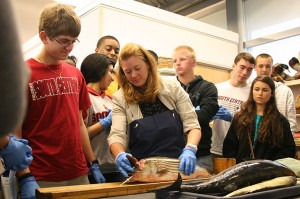
George Pate (left) and his classmates watch Coley Hughes open a striped bass skull to expose the cavity where the otoliths, or ear bones, reside. Photo by E-Ching Lee.
Students from South Central High School, just outside Greenville, are attending a review session for the Advanced Placement environmental science class. At the same time, they are being introduced to new material at the North Carolina Estuarium in Washington.
“I knew about tree rings but I didn’t know about the otolith,” observes George Pate, a senior.
Hughes collaborated with AP teacher Ann McClung and Estuarium curator Amy Van Staalduinen to develop a program on coastal ecology and water quality for the students.
The women had participated in a Research Educator Exchange Forum, or REEF, in 2012. Run by the Centers for Ocean Sciences Education Excellence SouthEast, also known as COSEE SE, the forum was designed to help marine scientists communicate their work to audiences beyond their research circle. North Carolina Sea Grant is among the program’s sponsors.
“The idea is to create a community of practice for the scientists,” explains Carrie Thomas, COSEE SE director. “We’re trying to introduce them to communications specialists, formal and informal educators, as well as media specialists so that they have a person that they can go to to develop ideas for proposals and outreach activities for their science.”
Participating researchers are responding positively. “I think it’s a great structure,” says John Godwin, a 2012 REEF participant who teaches biology at North Carolina State University. “The people doing it, their enthusiasm is infectious.”
Hughes agrees. “Just having this experience makes me want to do it more — more outreach programs and get more involved with the public,” she adds.
REACHING OUT
REEF is Thomas’s brainchild. The idea was born in 2010 when the focus of COSEE, a nationwide network of regional centers that supports and furthers marine science education, shifted. Priorities moved from providing professional development for teachers to building the communication skills of scientists.
Organizations that fund scientific research have started requiring scientists to communicate broader impacts, “which is another way of saying you’ve got to show how your results are affecting other people or why they’re important to other people,” explains Terri Kirby Hathaway, a member of COSEE SE and North Carolina Sea Grant marine education specialist. In other words, she says, researchers must go beyond preaching to the choir.
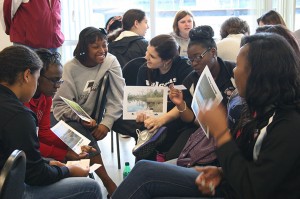
Students discuss the different aspects of various habitats during a group exercise. Photo by E-Ching Lee.
The first REEF was held in Columbia, S.C., in 2011 with participants from COSEE SE areas — North and South Carolina and Georgia. In 2012, Thomas conducted the forum in Raleigh. And in July, REEF will be held again in Raleigh. Georgia and South Carolina also hosted events this spring.
The workshop prepares early-career marine scientists — especially doctoral candidates, doctorate holders, post-doctoral fellows and pretenure faculty members — to develop and deliver an outreach activity for a specific audience at a local science center. However, all interested researchers are welcome.
Participants learn communication strategies for different target groups, such as the media, the public, teachers and students. Attendees are grouped by geographic region into communities of practice, or CoPs, to plan their program, with the expectation that proximity will facilitate collaborations.
Groups also are formed to balance different skill sets. The scientists provide subject expertise, the formal educators address standards-based approaches and the informal educators offer outreach-planning experience. Also, the educators can help the scientists fine-tune their language and methods for the intended audience.
“Having the teachers there as part of it was fantastic,” Godwin notes, adding that their presence helped him get a better feel for the challenges the educators face and what he needs to do to help them teach.
“The scientists get really excited. You see the scope of some of the projects. It’s pretty amazing what they do,” notes Thomas, who also is on faculty with the Department of Marine, Earth and Atmospheric Sciences at NC State.
The CoPs have designed events for classroom teachers, museum visitors and high-school students. REEF provides a small stipend to fund the outreach events. Sea Grant gives additional support that enables the CoPs to procure materials and supplies that are not covered by the initial grant.
Hathaway attended several REEF activities and is pleased by what she sees. “I’m so thrilled that these early-career scientists are thinking about other ways to share their research,” she says. “That’s the most valuable lesson that has come out of REEF — just getting them to think about sharing their research with different audiences in different ways.”
ESTUARY WETLANDS
Back at the Estuarium, McClung’s students learn how Hughes uses otoliths to determine fish age and water quality. She gives the students a demonstration of what she does in the lab — cutting, measuring and weighing the fish she collects. She even recruits students to help record data in her notebook.
“It’s interesting to know all that about a fish from a little bone,” says junior Cameron Merricks.
“This is a great opportunity for the kids to come out and see this,” says McClung, referring to Hughes and her hands-on research activities, and the Estuarium and its neighboring wetlands. The science teacher hopes that such exposure will interest her students in careers in the sciences.
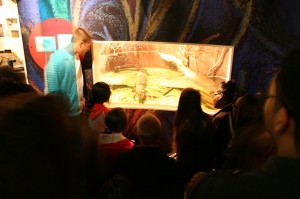
Students gather around the alligators at the N.C. Estuarium to learn about food webs. Photo by E-Ching Lee.
The review session was her idea. When the three women formed a CoP, McClung knew she was going to have a class of students preparing for the environmental science AP exam around the time the CoP wanted to hold an event. Van Staalduinen offered the Estuarium and her wetlands expertise. Hughes was conducting water-quality research. The women pooled their resources and this field trip was the result.
While this review session is specially designed for these students, Van Staalduinen notes that the Estuarium could gain something too: a way to reach new audiences.
“It opens up a new area for us, because usually the groups that come are elementary kids. So if we can bring in more high-school kids, that’s one thing we really wanted to do,” she says.
Hughes, whose work has been funded by the N.C. Fishery Resource Grant Program administered by Sea Grant, sees potential in the connections made through REEF. “I feel like once you establish these partnerships, who knows? They can keep going.”
This is exactly what Thomas hopes will happen. Beyond sharing ideas, she sees REEF as a networking opportunity for all present, including COSEE SE staff and invited speakers.
“Part of the reason we went with this model was just to provide the introductions so that everybody could say, ‘Here’s what we have to offer. How can we make it work?’ ” she explains. “It’s up to them to organically decide what fits the science, the facility and the personalities. But that introduction… it doesn’t happen on its own.”
Thomas hopes more collaborations will emerge. “Once a research group has a list of contacts — say ‘I met you at X workshop’ or ‘we actually developed a program together’ — then it makes it easy to see the possibilities. And our hope is it carries forward,” she continues.
URBAN WETLANDS
At the Walnut Creek Wetland Center in Raleigh, Godwin, NC State doctoral student in biology Melissa Slane and Meredith Kintzing, a postdoc in marine sciences at the University of North Carolina at Chapel Hill, led a mix of lectures and outdoor water sampling in early April.
Connecting their coral reef research with a piedmont-based audience was a challenge the team faced, as was the task of communicating with nonscientists.
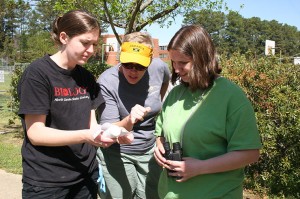
Melissa Slane , Kelly Hendrix and Abby Black read the pH of the water sample from the Little Rock Creek. Photo by E-Ching Lee.
“Because we’re centrally located and all of us do coastal research, it was really useful to learn how better to try and take my work and then make it applicable to people not necessarily at coastal environments,” Kintzing explains.
In addition, the researchers incorporated the syllabus requirements for middle and high schools into their presentations, gearing the event for classroom teachers. Middle-school teachers John Fout and Bill Martin assisted with the planning and provided materials for the session.
Kelly Hendrix, a nature program coordinator with Raleigh Parks and Recreation, singles out Slane’s presentation on five-lined skinks, a small lizard found at the Raleigh wetland.
“She did a good job relating the creeks and coast to this local area, talking about our local animals, and relating it back to what happens on our coastal areas,” Hendrix says. “She did a really good job talking to the whole audience.”
Nikki Black was pleased with the level of instruction, particularly for her ninth-grade daughter, Abby.
“It was a good environment to give her a taste of what it would be like in the college atmosphere,” says Black, who homeschools her children.
Black hopes that the researchers will continue to offer similar classes. “If this was any indication of what’s to come, we would really support that. And I’m going to bring this information back to our homeschool community and encourage them to get involved in these kinds of things as well,” she says.
The team wants to do more too. Godwin and Kintzing have talked to Sherry Graham, another member of the Raleigh-based CoP and the director of the wetland center, about potential future activities.
“It’s a really good stepping stone for future outreach activities,” Kintzing says.
SHARING RESEARCH
Follow-on projects already are happening. Brian Hopkinson, a University of Georgia researcher and 2011 REEF participant, received NSF funding to expand work related to his REEF outreach program. He collaborated with COSEE SE and several middle- and high-school teachers, including one of his CoP members, science teacher Vicki Soutar from Oconee County High School, to develop an ocean acidification toolkit for Georgia teachers.
Soutar uses the materials in her oceanography and earth science classes. “I appreciate working with research scientists since it helps me develop more engaging lessons, brings me up to date on the latest research and allows me to ask questions to further understand concepts, such as ocean acidification, which makes me a better teacher for my students,” she says of the experience.
“I also learned that research scientists can learn how to further their educational outreach more effectively if they will work with teachers to do so,” she adds.
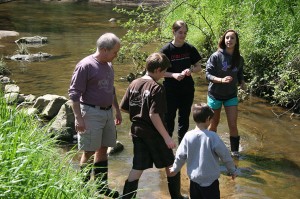
John Godwin (left) and Slane (third from left) wade into the water to help young workshop participants gather water samples. Photo by E-Ching Lee.
This spring, a new cohort of young scientists was introduced to the REEF concept. Georgia and South Carolina held the forum in March and April, respectively. Those CoPs are well on their way to using what they have learned and the connections they have made at REEF to plan — and hold — their events.
Brittany Bruder and Carolyn Perry were the first of the 2013 REEF participants to have an outreach event. They organized a small activity within a larger Girl Scouts program in Savannah, Ga. The pair already was discussing an outreach project when they went to REEF.
“We had ideas but I don’t know if they would have come together as well or as quickly or as fully if we hadn’t had the REEF experience,” says Perry, program director for the Center for Education Integrating Science, Mathematics, and Computing at Georgia Institute of Technology.
“Definitely if you already have an idea, it’s a really good place to foster it and meet people that can make it happen,” says Bruder, who enjoyed having the time to brainstorm ideas with Perry on the way to the REEF meeting.
Alex Chow, who teaches biogeochemistry and environmental quality at Clemson University, has been organizing an annual firefly count for several years through the Vanishing Firefly Project. The networking opportunities he found at the 2013 REEF workshop in Georgetown, S.C., helped him improve this year’s event.
“More important to me is making the connection to different people,” Chow explains. In earlier firefly counts, he struggled to find enough volunteers. But after meeting individuals from local organizations at REEF, “I don’t need to worry about the number of people. We already have four or five workshops set up at different places. And I don’t need to worry too much about advertisements or getting the people to know what we’re doing here.”
MOVING FORWARD
Continuity and sustainability are on Thomas’s mind these days. Funding for REEF and COSEE SE concludes at the end of 2013. Soon, she will conduct participant evaluations to determine if the REEF program has lived up to expectations.
Outreach is increasingly valuable, says Lundie Spence, retired COSEE SE director who was involved in REEF 2011 and 2012. She believes that the emphasis on outreach as a value-added part of research is here to stay, fueled by constrained funding and a growing expectation of accountability.
“The public needs to understand how research works and how science progresses. And having the research community have better strategies and skills in explaining what they do will help them,” says Spence, who was North Carolina Sea Grant’s marine educator for many years.
“We feel that the scientists really need to have a fan club that says ‘You’re doing important things’ and understands what they’re doing,” she adds. The communication skills and the professional networks developed at REEF workshops can help the researchers reach a broader community beyond their academic discipline.
Thomas’s goal is to help the scientists take that first step and become comfortable connecting with many audiences. “For us, it’s more important that they get out there and try it and learn,” she emphasizes. “We want them to do it again and again.”
This article was published in the Summer 2013 issue of Coastwatch.
For contact information and reprint requests, visit ncseagrant.ncsu.edu/coastwatch/contact/.
